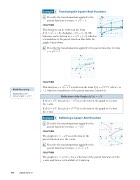Page 793 - Algebra 1
P. 793
Example
3
Translating the Square-Root Functions
a. Describe the transformations applied to the parent function to form y = √x - 3.
SOLUTION
This function can be written in the form
f(x) = √x + c by changing -3 to + (-3). The function can be written as y = √x + (-3) which is a translation of the parent function that shifts the graph 3 units down.
b. Describe the transformations applied to the parent function to form y = √ x + 2 .
y = √x +
SOLUTION
This function y = √x + 2 is written in the form f(x) = √x - c, where c is
-2, which is a translation of the parent function 2 units left.
Reflecting a Square-Root Function
O
x
-2
2
2
Math Reasoning
Analyze What is the domain of g(x) = √- x?
Reflections of the Graph of f(x) = √x
If f(x) = √x, then g(x) = -√x is a reflection of the graph of f across
the x-axis.
If f(x) = √x, then g(x) = √-x is a reflection of the graph of f across
the y-axis.
Example
4
a. Describe the transformations applied to the parent function to form y = -√x.
SOLUTION
778 Saxon Algebra 1
The graph of y = -√x is a reflection of the parent function over the x-axis.
b. Describe the transformations applied to the parent function to form y = √-x + 3.
SOLUTION
The graph of y = √-x + 3 is a reflection of the parent function over the
y-axis, and then a vertical shift of 3 units up.
y
4
y
= √ +
y = √x
2
y = √x + (–3)
y
4
2
y
= √x
x
-2
2
4
-2
x
3
2
y
y =
√x
O
x
-8
-4
4
8
-2
y
=
√
x


